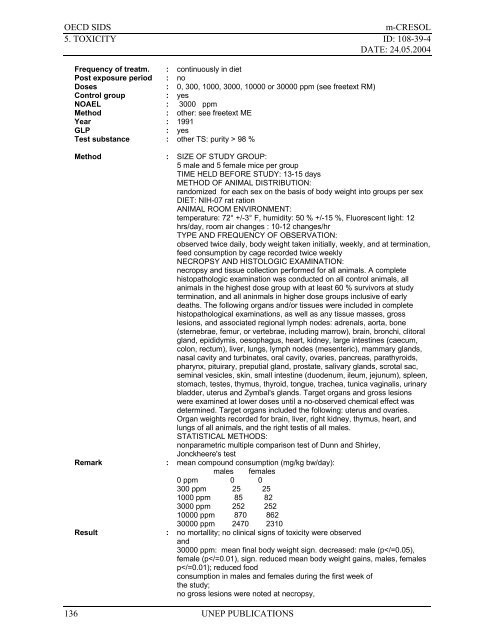m-Cresol - ipcs inchem
m-Cresol - ipcs inchem
m-Cresol - ipcs inchem
Create successful ePaper yourself
Turn your PDF publications into a flip-book with our unique Google optimized e-Paper software.
OECD SIDS<br />
m-CRESOL<br />
5. TOXICITY ID: 108-39-4<br />
DATE: 24.05.2004<br />
Frequency of treatm. : continuously in diet<br />
Post exposure period : no<br />
Doses : 0, 300, 1000, 3000, 10000 or 30000 ppm (see freetext RM)<br />
Control group : yes<br />
NOAEL : 3000 ppm<br />
Method : other: see freetext ME<br />
Year : 1991<br />
GLP : yes<br />
Test substance : other TS: purity > 98 %<br />
Method : SIZE OF STUDY GROUP:<br />
5 male and 5 female mice per group<br />
TIME HELD BEFORE STUDY: 13-15 days<br />
METHOD OF ANIMAL DISTRIBUTION:<br />
randomized for each sex on the basis of body weight into groups per sex<br />
DIET: NIH-07 rat ration<br />
ANIMAL ROOM ENVIRONMENT:<br />
temperature: 72° +/-3° F, humidity: 50 % +/-15 %, Fluorescent light: 12<br />
hrs/day, room air changes : 10-12 changes/hr<br />
TYPE AND FREQUENCY OF OBSERVATION:<br />
observed twice daily, body weight taken initially, weekly, and at termination,<br />
feed consumption by cage recorded twice weekly<br />
NECROPSY AND HISTOLOGIC EXAMINATION:<br />
necropsy and tissue collection performed for all animals. A complete<br />
histopathologic examination was conducted on all control animals, all<br />
animals in the highest dose group with at least 60 % survivors at study<br />
termination, and all aninmals in higher dose groups inclusive of early<br />
deaths. The following organs and/or tissues were included in complete<br />
histopathological examinations, as well as any tissue masses, gross<br />
lesions, and associated regional lymph nodes: adrenals, aorta, bone<br />
(sternebrae, femur, or vertebrae, including marrow), brain, bronchi, clitoral<br />
gland, epididymis, oesophagus, heart, kidney, large intestines (caecum,<br />
colon, rectum), liver, lungs, lymph nodes (mesenteric), mammary glands,<br />
nasal cavity and turbinates, oral cavity, ovaries, pancreas, parathyroids,<br />
pharynx, pituirary, preputial gland, prostate, salivary glands, scrotal sac,<br />
seminal vesicles, skin, small intestine (duodenum, ileum, jejunum), spleen,<br />
stomach, testes, thymus, thyroid, tongue, trachea, tunica vaginalis, urinary<br />
bladder, uterus and Zymbal's glands. Target organs and gross lesions<br />
were examined at lower doses until a no-observed chemical effect was<br />
determined. Target organs included the following: uterus and ovaries.<br />
Organ weights recorded for brain, liver, right kidney, thymus, heart, and<br />
lungs of all animals, and the right testis of all males.<br />
STATISTICAL METHODS:<br />
nonparametric multiple comparison test of Dunn and Shirley,<br />
Jonckheere's test<br />
Remark : mean compound consumption (mg/kg bw/day):<br />
males females<br />
0 ppm 0 0<br />
300 ppm 25 25<br />
1000 ppm 85 82<br />
3000 ppm 252 252<br />
10000 ppm 870 862<br />
30000 ppm 2470 2310<br />
Result : no mortallity; no clinical signs of toxicity were observed<br />
and<br />
30000 ppm: mean final body weight sign. decreased: male (p
















